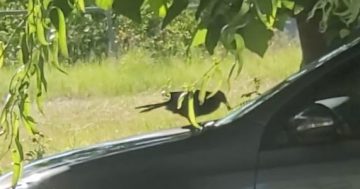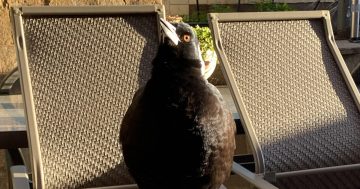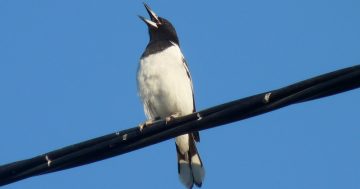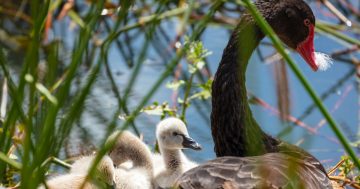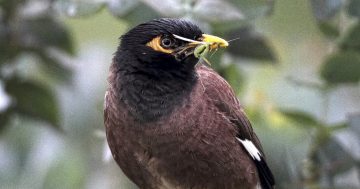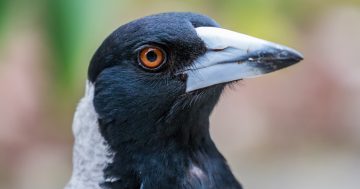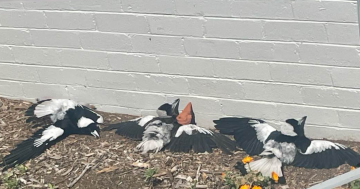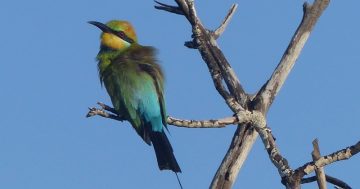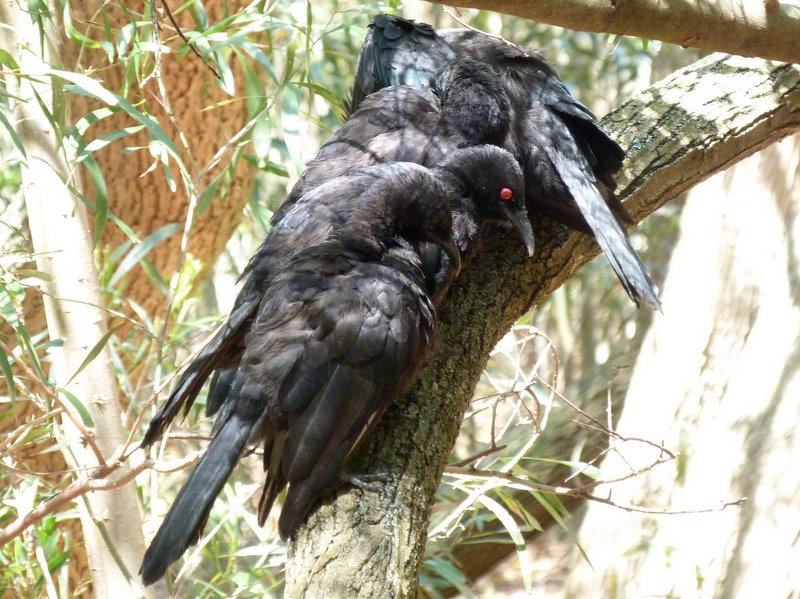
White-winged choughs are super-sociable. Here a family is huddling and preening. Photos: Ian Fraser.
We’ve all seen white-winged choughs in Canberra, even if all those black or black-and-white birds can be a bit confusing sometimes.
Once you get your eye in though, you’ll be able to pick out the choughs every time. They’re always in chatty groups, usually feeding on the ground, with slim curved beaks and bright red eyes (except for the youngsters).
At first, they look all black, but as soon as they fly they display broad white wing-tips.
And for the record, it’s pronounced ‘chuff’.
They’re all over Canberra, but usually not too far from a park or reserve where there’s open ground for feeding and trees for nesting.
The nest is a work of both labour and art. It is a large mud structure, bound with grass or bark, which is also used to carry the mud to the nest. The previous year’s nest is often repaired and extended – building from scratch is a major task.
Choughs do everything together, including nest-building.
All members of the family carry the mud, but young birds really have no idea what to do. It’s a bit like children in the kitchen in that it’s good for them, but not much use to the finished product.
Most small birds nest in their first year, so have never seen a nest being built – they just ‘know’. Choughs, however, don’t have a clue, so they must stay home for at least four years to learn the trade.
Territories are held fiercely, though in winter they break down and large flocks may form, ranging much more widely than usual in search of food. When times are hard they may visit backyard feeders, which they rarely do in warm seasons.
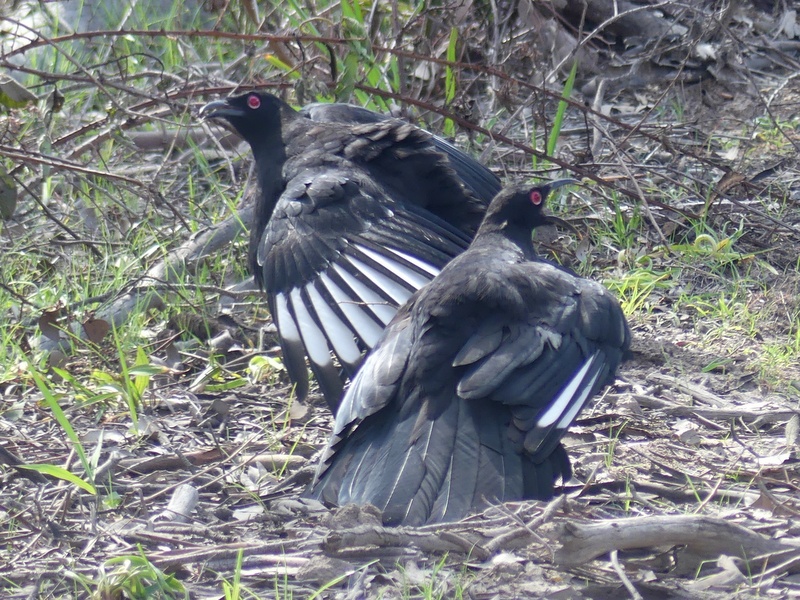
White-winged choughs responding to a threat with bulging eyes and flashing white wings.
All members of the territory group must participate in feeding the nestlings.
Food comprises insects and seeds, but the most important food for chicks is big underground grubs, which take time and skill to find and extract.
It’s not possible for a pair of choughs to bring enough food to the nest on their own, and it has been calculated that the parents need two helpers to successfully raise each chick.
If the group size falls too low, something extraordinary happens.
It’s all too easy for us to pass judgement on animals as if they were humans – as if we’re ever in a position to take the moral high ground! – and what I’m about to recount will probably outrage some people.
If the number of helpers falls too low then this year’s chicks will die, and so will all the coming years’ broods unless numbers can be boosted.
How can this happen? The answer, improbably, lies in a very deliberate strategy of kidnapping youngsters from the neighbours!
The family will pick a fight with a (usually smaller) neighbouring group of choughs by invading their territory. In the ensuing chaos, a couple of adult choughs from the aggressors will approach baby choughs recently out of the nest, and with offerings of food entice them back into their own territory.
When this is accomplished they break off the invasion, form around the confused chicks and take them out of reach of their own family.
As long as the chicks are less than four weeks out of the nest this works successfully and they become integrated into their new family.
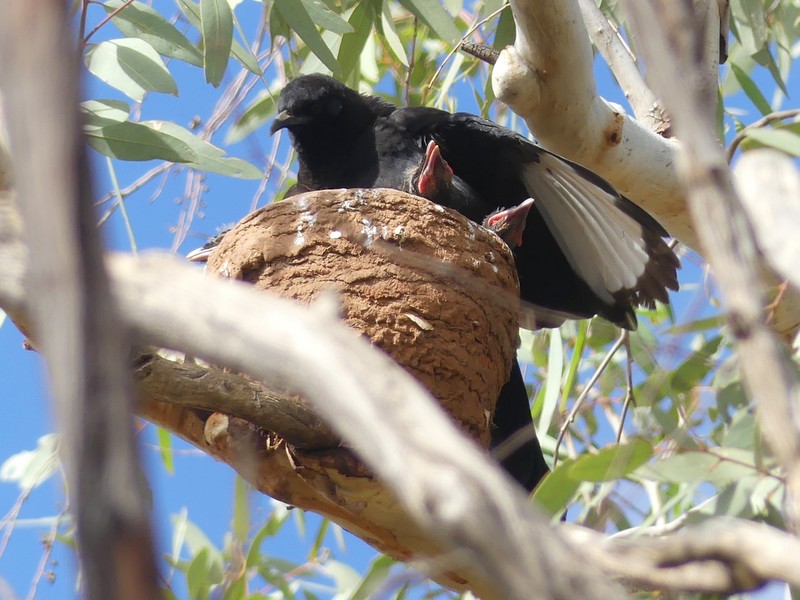
White-winged chough with chicks on the big mud nest.
If they’re older than that, though, the bonds are already too strong and the abducted young birds are likely to flee home again.
While their initial efforts won’t be enough to help feed the nestlings of their new family, in time they will make the difference between the family’s success and failure.
Not that the choughs are always the aggressors, by any means. Magpies seem to go out of their way to give choughs a rough time. They will often swoop on a group of foraging choughs, snapping and yelling angrily.
The choughs have an effective response, however, and while they might initially scatter they rarely run away. They instead rush into a tight circle, facing the threat with open beaks and bulging red eyes. It is spectacular to see, and one early researcher – the Canberra-based CSIRO scientist Ian Rowley – memorably described it as the ‘plum pudding display’.
When next you come across a family of choughs moving over the ground, looking for grubs and calling to each other with musical fluting notes, stop a while and watch these wonderful old Australians. I’m sure it will enrich your day as it always does mine.
Ian Fraser is a Canberra naturalist, conservationist and author. He has written on all aspects of natural history, advised the ACT Government on biodiversity and published multiple guides to the region’s flora and fauna.












